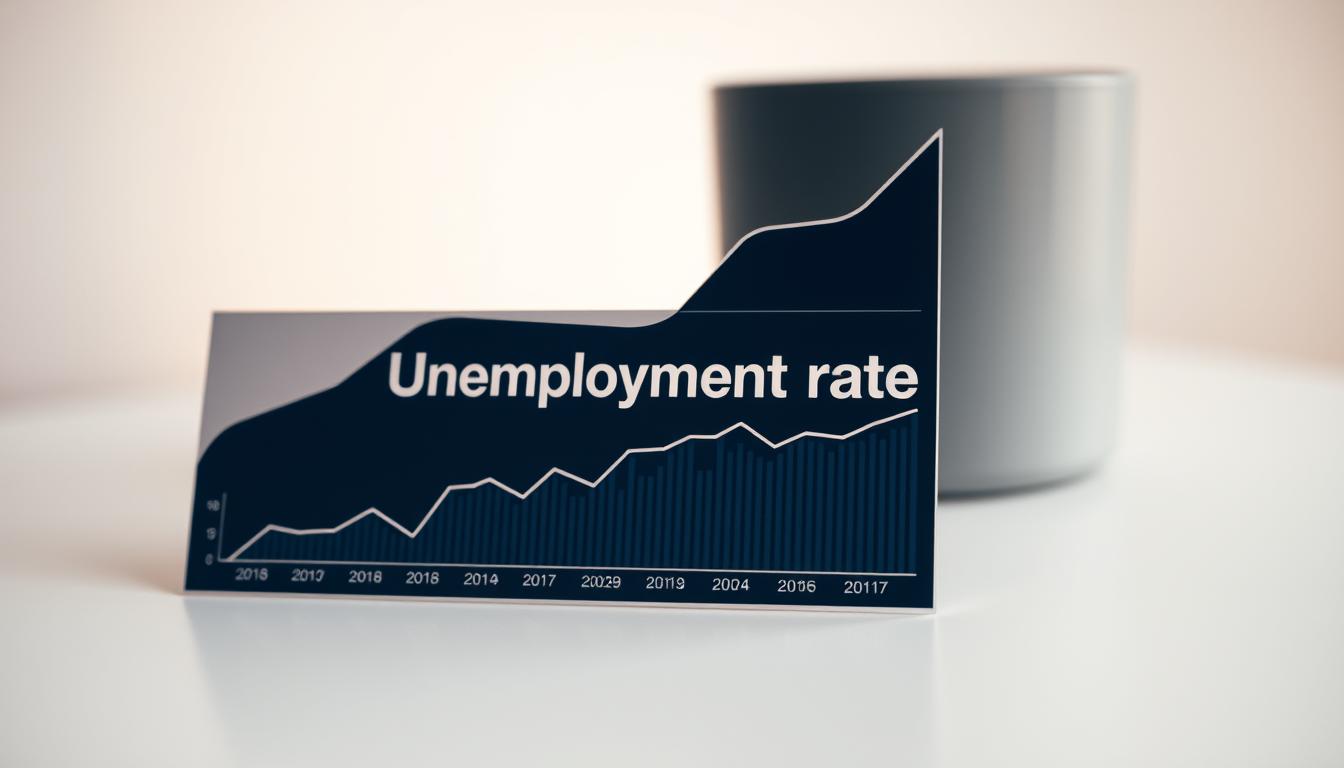Anúncios
The unemployment rate shows the share of people looking for work but can’t find any. It’s key for understanding how the economy is doing. It tells us about job availability and the market’s condition. The Bureau of Labor Statistics (BLS) updates this rate every month. This helps us see how employment is changing over time.

GBTI Visa Gold Card
Keeping an eye on the unemployment rate is important. It helps understand the economy’s health. It also impacts decisions made by the government and the Federal Reserve.
Anúncios

What Is the Unemployment Rate?
The unemployment rate shows how healthy an economy is. It’s important to know what this rate means for job seekers. This rate tells us what portion of people looking for jobs can’t find work. The Bureau of Labor Statistics (BLS) uses the U-3 rate to track this. It counts people who have been looking for a job in the last four weeks.
Anúncios
Definition of Unemployment Rate
Finding out what the unemployment rate is matters a lot. It includes people who are jobless but ready and able to work. This number helps us understand the economy’s condition and the job market. It mainly looks at those trying to find jobs, showing us the labor that’s available.
Importance of Tracking the Unemployment Rate
Unemployment stats are more than just numbers. They help economists and policymakers figure out how strong the job market is. They use these numbers to shape economic policies. A change in unemployment can signal shifts in the economy. It affects how people spend and feel about their finances. Keeping an eye on this rate helps solve job market issues by improving job chances.

How Is the Unemployment Rate Calculated?
Understanding how we calculate unemployment is key to grasping economic health. The Bureau of Labor Statistics (BLS) uses a detailed method to measure this important figure. This method makes sure the data correctly shows what’s happening in our nation’s job market. By looking into this data, we learn about both joblessness and how many people are working or looking for work.
Steps Taken by the Bureau of Labor Statistics (BLS)
To figure out the unemployment rate, the BLS follows several steps:
- Each month, it surveys about 60,000 households to collect job information.
- People are put into three groups: those with jobs, those without jobs but looking for one, and those not seeking employment.
- To find the unemployment rate, divide the number of people without jobs by the total number of people in the workforce.
Understanding the Labor Force Participation Rate
The labor force participation rate is crucial for evaluating economic health. It shows the percentage of people of working age who are either working or job hunting. Shifts in this rate can greatly affect unemployment figures. When fewer people participate in the labor force, it might hide the real number of unemployed. But, if more people are getting into the workforce, it suggests economic growth and more job opportunities.
Current Trends in Unemployment Rates
Knowing about unemployment trends helps us understand the economy’s health. As of May 2025, the unemployment rate is 4.2%. This number has been stable for some time, showing how the economy is doing. The Bureau of Labor Statistics (BLS) says a 4.2% unemployment rate means the job market is working well. However, looking at the past ten years is important to get the full picture.
National Unemployment Rate Data
Recent reports from the BLS show how the unemployment rate has changed. Here are the main points:
- The unemployment rate went up during tough times, like after COVID-19 hit.
- When the economy started to get better, unemployment rates slowly went down.
- The unemployment we see now fits with the patterns we’ve seen before, helping us understand today’s numbers.
Unemployment Rates Over the Past Decade
In the last ten years, unemployment rates have really changed. Many factors and events have caused these changes:
- The COVID-19 pandemic started, causing a huge increase in unemployment.
- As things began to improve, unemployment rates started to drop as the economy opened back up.
- Challenges like changing demands in different industries have also affected unemployment rates.
Looking at unemployment through history helps us understand how economic ups and downs affect jobs. This knowledge is key to guessing future job market trends.
Unemployment Rate by State
The unemployment scene across the U.S. is quite mixed. Some states are doing very well, while others are struggling more. This is because different places have their own challenges that affect jobs. A look into recent numbers shows big differences in job rates between states.
States with Highest and Lowest Unemployment Rates
In May 2025, South Dakota had the lowest jobless rate at 1.8%. This signals a strong economy and industries that are doing well. On the flip side, Nevada faced the highest rate at 5.5%. This tells us about the struggles and adjustments in its job market. Such differences highlight how policies and industries shape job availability.
Regional Variations in Unemployment Rates
Different parts of the country see various job rates due to unique reasons. The Midwest, for instance, often has fewer unemployed. This is thanks to a mix of jobs in farming and making things. Coastal areas, however, might have more job ups and downs due to relying on tourism. Knowing about these regional traits helps us understand the bigger job picture.
Understanding Different Categories of Unemployment
The Bureau of Labor Statistics (BLS) breaks down unemployment into several groups. Each group shows different problems in the job market. Learning about these, especially the difference between U-3 and U-6, helps us understand the job scene and its effects on the economy better.
Types of Unemployment: U-3 vs. U-6
The U-3 rate is what we often hear as the official jobless rate. It counts people who don’t have jobs but are trying to find work. On the other hand, the U-6 goes further. It includes people who aren’t looking that hard or can only find part-time jobs. This shows us there’s more to job numbers than meets the eye.
Other Alternative Measures of Unemployment
Besides U-3 and U-6, there are more ways the BLS measures job issues, like U-1 through U-5. These metrics address different parts of job market troubles:
- U-1: Represents persons unemployed for 15 weeks or longer.
- U-2: Includes job losers and persons who completed temporary jobs.
- U-3: The official unemployment rate as discussed earlier.
- U-4: Incorporates discouraged workers who have quit seeking employment.
- U-5: Encompasses all marginally attached workers.
- U-6: The most comprehensive measure, factoring in those working part-time for economic reasons.
These categories give us a detailed view of job market issues. They help explain how the economy is doing and guide leaders in making job policies.
Factors Influencing the Unemployment Rate
The unemployment rate is affected by many factors in the economy. It reacts quickly to changes in economic conditions and government policies. Learning about these factors helps us understand the labor market and the economic state of a country.
Economic Conditions and Their Impact
Economic conditions have a big impact on the unemployment rate. It changes with how businesses do, how confident consumers feel, and the health of the market. Here are some key factors:
- Labor Demand: During economic growth, more jobs are available, so fewer people are unemployed.
- Business Investments: When companies invest more, it can create jobs and reduce the unemployment rate.
- Consumer Confidence: If people believe the economy is stable, they spend more. This makes businesses hire additional employees.
Role of Government Policies
Government policies are very important in determining employment levels. They can shape labor markets in several ways:
- Fiscal Policies: Government spending can stimulate the economy and increase job opportunities during tough times.
- Monetary Policies: Lower interest rates encourage more borrowing and investing, which helps maintain employment levels.
- Labor Regulations: Laws about employment affect job security and conditions in the workplace. They influence how and when companies hire.
The Impact of Unemployment on the Economy
Unemployment and the economy are closely linked, affecting economic health in many ways. It not only impacts workers but also the productivity of entire industries and buying habits. Understanding how unemployment rates change helps us see the big picture of the economy.
Correlation Between Unemployment Rate and Economic Growth
The link between unemployment and economic growth is clear in economic patterns. When unemployment is low, more people have jobs, leading to more consumer spending. This boost in spending increases demand for products and services, helping the economy grow. On the other hand, high unemployment means fewer people are working and spending less money. This can slow down economic growth.
Unemployment and Inflation Relations
The way inflation and unemployment relate adds complexity to the economy. With low unemployment, the demand for workers goes up, which can push wages higher. Then, businesses might face higher costs and might raise their prices to keep making a profit. This can cause inflation. It shows how important it is for economies to balance job levels and stable prices. Policymakers need to understand these aspects to support ongoing economic growth.
The Role of the Bureau of Labor Statistics
The Bureau of Labor Statistics is key in tracking US unemployment. It’s the top source for collecting and sharing info on jobs. They use detailed research and stats to make sure the information they give out is correct and useful. This info helps everyone from government officials to the public.
They do regular surveys to gather lots of data on jobs and how markets are doing. This data helps us see trends in work, how different job areas are performing, and the overall state of jobs. These insights are crucial for making economic decisions and getting a clear picture of the job market.
Functions of the BLS in Unemployment Measurement
- Conducting the monthly Current Population Survey, which forms the basis for the national unemployment rate.
- Utilizing the Local Area Unemployment Statistics program to provide unemployment rates at the state and local level.
- Distributing comprehensive reports that inform various stakeholders about employment dynamics, including industry performance and demographic changes.
The BLS plays a clear role in measuring unemployment. Their hard work in getting unemployment figures right helps us all understand the economy and job trends in the US.
Historical Context of the Unemployment Rate
The way we look at the unemployment rate’s history shows us how big economic troubles shape job trends. Events like the Great Depression, the Great Recession, and the COVID-19 pandemic have all changed how many people are out of work. By looking at the history of unemployment, we can understand the big impact of economic crises.
We get to see how well the workforce can bounce back during hard times.
Unemployment Rate During Economic Crises
When the economy goes downhill, unemployment rates go up. Big crises in the past include:
- The Great Depression in the 1930s, which saw unemployment reach nearly 25%.
- The Great Recession of 2007-2009, which led to an unemployment peak of 10%.
- The COVID-19 pandemic, where unemployment surged to unprecedented levels in 2020.
These times show us how jobs can be hit hard by economic crises, leading to more people without work.
Long-term Trends in Unemployment Rates
Looking at unemployment over time shows us patterns from economic policies, tech changes, and world events. We see things like:
- Decline in unemployment rates during consistent periods of economic growth, like the late 1990s.
- Fluctuations in response to policy changes, including tax reforms and stimulus packages.
- A gradual shift in workforce demographics that affects overall labor participation rates.
This knowledge helps us understand how the job market keeps evolving. It prepares us for future changes.
Public Perception of the Unemployment Rate
People’s views on unemployment shape how they spend money. When more folks are out of work, a lot worry about their own jobs. This worry makes them careful with their money, affecting the economy.
How the Unemployment Rate Affects Consumer Confidence
A high jobless rate often leads to a gloomy outlook. People get nervous about their money, spending, and investing less. Key factors in consumer confidence are:
- Perceived job security
- Overall economic stability
- Future job market expectations
When jobs seem shaky, many choose to save rather than spend on extra things. This caution can slow down businesses and lead to more job cuts, continuing a tough cycle. Yet, when fewer people are out of work, it boosts spending and helps the economy grow.
Analyzing Future Projections of Unemployment Rates
To understand future unemployment, we must watch the economy’s signs. These include changes in GDP, how many people are working, and how confident consumers feel. These signs are key to guessing employment trends and getting ready for changes.
Forecasting jobs also uses past and present data. Experts look at old economic patterns and today’s conditions. This helps them predict future job trends. It also guides leaders in making plans. This way, the economy and job market can be better managed.
Conclusion
Understanding the unemployment rate helps us know how healthy the U.S. economy is. This important measure shows us the state of the job market and what might happen in the future. Our analysis shows why it’s important to keep an eye on unemployment rates.
As the economy changes, watching the unemployment rate is key for everyone involved. It shows how well the job market can adjust to economic ups and downs. We’ve learned that making the right policies can help tackle new challenges.
The future of jobs depends on economic growth, government actions, and social issues. People need to watch these factors closely, as they will decide how many job opportunities there are. This article gives us valuable know-how to face future job market challenges.


